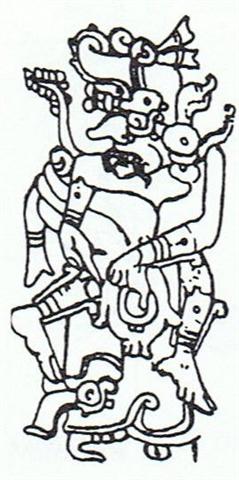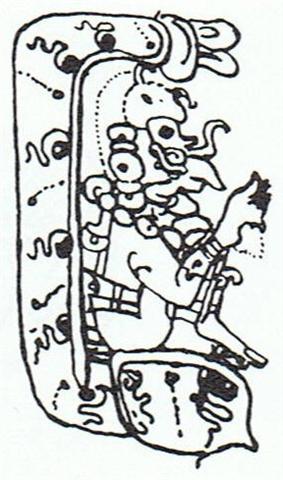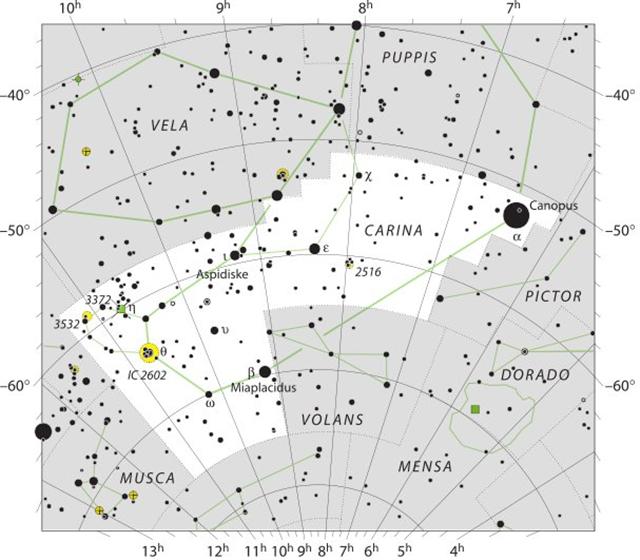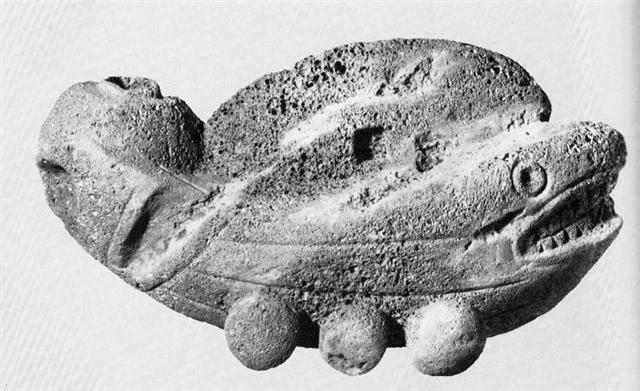Let's return to
the words of Metoro. His erua
tamaiti means 'twins'
(literally 'two children'),
which, however, does not
necessarily refer to the Gemini
twins:
|
Al Tuwaibe' 6 |
7 |
8 (413) |
9 (49) |
|
July 1 |
2 |
3 |
4 (185) |
|
(178) |
(179) |
(180) |
(181) |
 |
 |
 |
 |
|
Ca4-26 (102) |
Ca4-27 |
Ca4-28 |
Ca4-29 |
|
erua
tamaiti |
kua vaha te
mago
erua |
|
ψ6 Aurigae
(101.7),
τ
Puppis (102.2),
ψ7 Aurigae
(102.4) |
ψ8 Aurigae
(103.2) |
Alhena (103.8),
ψ9 Aurigae
(103.9) |
Adara (104.8),
ω Gemini (105.4) |
|
Al Tuwaibe' 10
(50) |
11 |
12 |
13 |
|
July 5 (186) |
6 |
7 |
8 |
 |
 |
 |
 |
|
Ca5-1 |
Ca5-2 (107) |
Ca5-3 |
Ca5-4 |
|
E hua ki te
henua - ka huki |
te hau tea -
te henua |
kua hua |
te henua |
|
Muliphein
(105.8) |
Wezen (107.1) |
no stars listed |
|
Heka 1 |
2 |
3 |
4 (57) |
|
July 9 |
10 |
11 |
12 (193) |
 |
 |
 |
 |
|
Ca5-5 |
Ca5-6 (111) |
Ca5-7 |
Ca5-8 |
|
kua iri i te
rakau |
ihe tamaiti |
erua mago |
|
Wasat (109.8) |
Aludra (111.1) |
Gomeisa (111.6),
ρ Gemini (112.1) |
Castor (113.4) |
But
ihe tamaiti at Ca5-6
- a glyph which is drawn
in the same way as Ca4-27 - is
support for the idea of
a reference to the
Gemini pair, because the
heliacal rising of
Castor is close by. A
single 'eye' could
indicate a state of
mortality (e.g. because
Metoro said ihe).
Tamaiti in Ca4-26
would then be Pollux.
My rule of thumb
according to which a
pair becomes the
negation of the single -
for example kaikai (nothing
to eat = no
Sun) as
the opposite of kai
(eating) - possibly
should be used also in
order to interpret the
meaning of the 2nd
identical tamaiti
in Ca5-6. Furthermore, Metoro said
ihe tamaiti and
ihe could here mean
'spear' (the point of
which will 'kill').
|
Ihe
A
fish. Vanaga.
1. Mgv.: ihe,
a fish. Mq.:
ihe, id.
Sa.: ise,
id. Ma.: ihe,
the garfish. 2.
Ta.: ihe,
a lance. Ha.:
ihe, a
spear. Churchill |
There are 60
days from another pair of
twins in line Ca2, and
possibly they are female
(because of their 'nipples'
at bottom and their plump
bodies):
|
Alrescha 1 |
2 |
3 |
4 (354) |
5 |
|
May 2 (122) |
3 |
4 |
5 |
6 |
 |
 |
 |
 |
 |
|
Ca2-16 |
Ca2-17 |
Ca2-18 |
Ca2-19 (45) |
Ca2-20 |
|
erua tamaiti |
ki
te huaga o te hoi
hatu |
e
tagata poo pouo |
te
vai |
|
no
stars listed |
Acamar
(43.6) |
Menkar (44.7) |
3h (45.7)
Algol (45.9) |
The word
tama-iti does not say if
the 'little child' is a
little boy or a little girl.
122 (May
2) = 2 *
61 and 350 + 122 = 472.
Al Sufi (who may have
been the one who first
described the star
cluster at
ο Velorum) has a picture
for Gemini where 15 (?)
toes are outside the
rectangular frame:

We can compare with the
14 toe marks in the 3rd Rain
God station:
  
Pushing
feet and toes into the
soft earth could
correspond to an act of
impregnating, a sign of
generating offspring.
In the 4th
Rain God station, where he
turns around, we can imagine
the 'Tree' located partly on
one side and partly on the
other side - like when
Capella is on one side of
the Milky Way with Canopus
and Sirius on the other:
|
Capella |
α Aurigae |
0.08 |
|
Milky Way |
| Sirius |
α Canis Majoris |
-1.46 |
| Canopus |
α Carinae |
-0.72 |
The 5th
station of the Rain God
should consequently come
after the June solstice.
He is there shown sitting
for himself down inside
the earth. The monster head at
bottom of the Milky Way
tree, which is turned around
in the 4th station, has
in the 5th station
a mirror image looking forward and used by the Rain God
like a cusion to sit upon.
In contrast to the
'Tree' - growing tall -
we can expect the
opposite in the
following station. Time
will begin anew from a
position far down (like
the beginning of a
rongorongo text). Argo
Navis could be the place
where to look.
To be more precise, we
should look for clues at
the very bottom, in the
Keel (Carina):

I have placed Canopus as
the monster head at the
bottom of the
'Tree' and the rest of
the Keel has apparently another
character. The first
star to rise in the Keel
proper should therefore
be χ Carinae:
|
Heka 10 |
11 (64) |
|
July 18 |
19 (200) |
 |
 |
|
Ca5-14 |
Ca5-15 (120) |
|
kua haga te
mea ke |
manu puoko i
tona ahi |
|
no star listed |
χ Carinae
(119.9) |
|
Heka 12 (65) |
13 |
Alhena 1 |
2 |
3 (69) |
|
July 20
(201) |
8h (121.7) |
22 |
23 |
24 (205) |
 |
 |
 |
 |
 |
|
Ca5-16 |
Ca5-17 (122) |
Ca5-18 |
Ca5-19 |
Ca5-20 (125) |
|
kua heu te
huki |
hakahagana
te honu |
tagata
moe hakarava
hia |
ka moe |
hakapekaga
mai |
|
Naos (121.3) |
Heap of Fuel
(122.1) |
Tegmine
(123.3),
Regor
(123.7) |
Al Tarf
(124.3) |
Bright Fire
(125.4) |
Here
the 'bird head' (manu
puoko) is 'in
his fire' (i tona
ahi), according
to Metoro.
|
Ahi
Fire;
he-tutu i te
ahi to
light a
fire.
Ahiahi =
evening;
ahiahi-ata,
the last
moments of
light before
nightfall.
Vanaga.
1. Candle,
stove, fire
(vahi);
ahi
hakapura,
match;
ahi
hakagaiei,
firebrand
waved as a
night
signal. P
Mgv.: ahi,
fire, flame.
Mq.: ahi,
fire, match,
percussion
cap. Ta.:
ahi,
fire,
percussion
cap, wick,
stove. 2. To
be night;
agatahi ahi
atu, day
before
yesterday.
3. Pau.:
ahi,
sandalwood.
Ta.: ahi,
id. Mq.:
auahi, a
variety of
breadfruit.
Sa.: asi,
sandalwood.
Ha.:
ili-ahi,
id.
Ahiahi,
afternoon,
night;
kai ahiahi,
supper. P
Pau., Mgv.,
Mq., Ta.:
ahiahi,
afternoon,
evening.
Ahipipi
(ahi
1 - pipi
2) a spark,
to flash.
Churchill. |
Perhaps Metoro
thought the position
of the bird was
comparable to being
in an earth-oven (umu):
|
Umu
Cooking pit,
Polynesian
oven
(shallow pit
dug in the
ground, in
which food
is cooked
over heated
stones); the
food cooked
in such a
pit for a
meal,
dinner, or
banquet;
umu pae,
permanent
cooking pit,
in a stone
enclosure.;
umu
paepae,
permanent
cooking pit
with straw
cover for
protection
from rain
and wind;
umu keri
okaoka,
temporary
cooking pit
without
stone
enclosure;
umu ava,
very
large
temporary
cooking pit,
made for
feasts;
umu takap˙,
exclusive
banquet,
reserved for
certain
groups of
persons, for
instance the
relatives of
a deceased
family
member;
umu tahu,
daily
meals for
hired
workers;
umu
parehaoga,
inaugural
banquet
(made on
occasion of
a communal
enterprise
or
feastival);
umu ra'e,
banquet
for fifth or
sixth month
of
pregnancy;
umu
pÔpaku,
banquet on
occasion of
the death of
a family
member.
Vanaga.
Cooking
place, oven
(humu).
Churchill.
Samoa,
Maori,
Nukuoro,
Niue,
Tahiti,
Hawaii,
Mangaia,
Marquesas,
Mangareva,
Paumoto:
umu,
oven. Tonga:
ngotoumu,
id. Uvea:
ngutu¨mu,
id. Futuna:
¨mu-kai,
id. Fotuna:
amu,
cooking
place.
Rapanui:
umu,
oven;
humu hare,
cook house
... The
Polynesian
radical is
consistently
umu.
Tonga and
Uvea
compound
with it a
word which
in Uvea is
distinctly
ngutu
mouth and in
Tongan we
may feel
that
ngutu
has been
specifically
differentiated
in this
composite.
In the
Futuna
composite
the latter
element is
merely
kai food
...
Particular
interest
attaches to
the
discovery of
the amu type
in Mabulag
and Miriam,
western and
eastern
islands of
the straits
and remote
from the New
Guinea coast
... The
existence of
amu
in Fotuna
affords us
reason to
regard the
type as
ancient
Proto-Samoan,
and that
Mabulag and
Miriam
received it
directly and
not on
secondary
loan from
Motu.
Churchill 2. |

...
The image is that of
a reed boat with a
whale's or sea
monster's head at
the bow, and a
skull-like mask at
the stern. At the
top of the stern is
a five-sided umu,
or Easter Island
fireplace, and on
deck is a hare
paenga, or
lenticular reed
house, with a square
doorway on the
starboard side. On
the same side, a
wide channel
surrounded by a
V-shaped groove
leads down from the
deck aft ...
|















